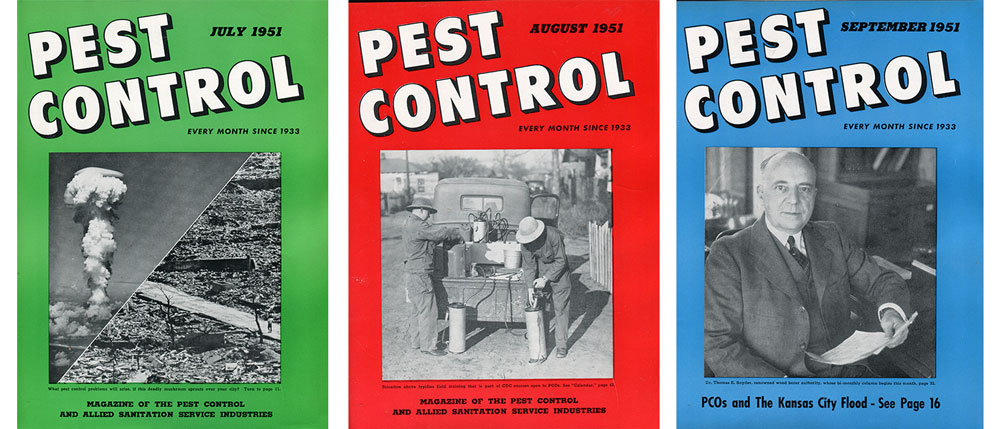Hollywood got creative when showing what would happen to pests exposed to radiation from atomic and hydrogen bombs. Gigantic insects terrorized towns in Them! (ants), Beginning of the End (grasshoppers), The Monster that Changed the World (slugs), and Monster from Green Hell (wasps), movies released in the 1950s.
In 1951, Pest Control — Pest Management Professional before its name change in 2007 — offered a different take in a three-part article titled, “What are the potential pest control problems in an atomic-bombed community?” The series ran in the July, August and September issues.
To understand why this topic would merit coverage, consider that World War II had just ended six years before with the bombings of Hiroshima and Nagasaki. The Cold War had begun, and Americans were instructed to “duck and cover” during Civil Defense drills.
Dr. Harold Elishewitz, a Chicago Medical School Assistant Professor of Parasitology, wrote the series and based his theories on conditions prevalent in Chicago. He got right to the point and began by stating:
We may classify the purely medical and public health phases of a Civilian Defense Program against the ravages of an atomic bomb attack into:
1. The preventive, i.e., those measures to be instituted before the attack takes place, such as the necessary planning, organization, training, stockpiling, and immunizing of the population against certain communicable diseases.
2. The immediate, i.e., measures to be instituted as soon after the disaster as possible. These refer mainly to the First Aid and hospitalization care of the wounded, burned, and those exposed to radiation.
3. The delayed, i.e., measures of less urgency whose introduction, although important, can be delayed until some time or even several days after the holocaust — time for the general confusion, mass hysteria, and wild fleeing to calm down, or, if immediate, pertain to areas outside of the actually damaged areas. These are the public health and sanitary aspects.
Of course, the preventive measures are the very base on which the proper introduction and use of the other remedial measures depend. Intelligent plans for a complete defense can only be based on a full knowledge of the potentialities possessed by the attacker and his plans for using the means which he has available. At the present, much of the preventive planning is based upon one unknown factor piled upon another. Although much basic rational planning and organization can and has been done, this planning is an extremely fluid condition at the present time due to these many unknowns.
Major public health problems which are apt to arise include: (1) water supply; (2) sewage; (3) vermin problems (insect-borne diseases, insect and rodent pests); (4) communicable diseases; (5) milk and food poisoning; (6) blood typing and vaccination; and (7) shelter and nutrition. We will consider here only group three — the vermin problems.
Vermin problems can be separated into several distinct categories, each engendered by a different phase of the problem and each of which will require a different remedial measure; viz., flies and fly-borne diseases, skin parasites and ectoparasite-borne diseases, and rats and rodent-borne diseases.
Flies
Dr. Elishewitz said high numbers of flies would breed on dead bodies, much like they did at battlefields during World War II. He theorized that conditions would be ideal for scavenger and flesh flies, and that house flies breeding in decaying organic matter could cause major outbreaks of dysenteries and typhoid fever.
Fly control is a two-phased problem: preventing the breeding of flies in the first place, via screening, proper sewage disposal, garbage collection and disposal, and general sanitation and fly eradication by insecticides. The result of an A-bomb attack probably will not only cause an increase in flies due to the destruction of part of the sewage system in the city, as well as worsen the garbage-collecting disorganization, but at the same time will prevent our using proper control measures against them.
… Fly control is a community problem, and must be met on a community basis. Central mobile fly-control squads should be organized, equipped with either individual 3-gallon knapsack or hand sprayers, truck-mounted high-pressure sprayers, or aerosol machines.
Rats
Garbage and the destruction of buildings and sewer systems would lead to rats and rat-borne diseases, he said.
The severe structural damage and attendant debris along with accumulations of uncollected garbage will produce ideal breeding places, feeding sites, and harborages for rats.
The incidence of … various diseases depends upon the presence of … infected rats, their flea populations, and the populations of rats themselves.
The rat problem here in Chicago, as well as in many other cities, is so severe that an adequate control or eradication program could not be carried out after an A-bomb explosion. It is one phase which should be started, organized and gotten well underway beforehand.
Dr. Elishewitz concluded other pests — including bed bugs, cockroaches and fleas — would not cause a “public health problem” and therefore could be “neglected.”
Although he never mentioned gigantic insects, Dr. Elishewitz did indicate that pest management expertise would be needed to keep people safe and help restore order during such a catastrophe.

Leave A Comment